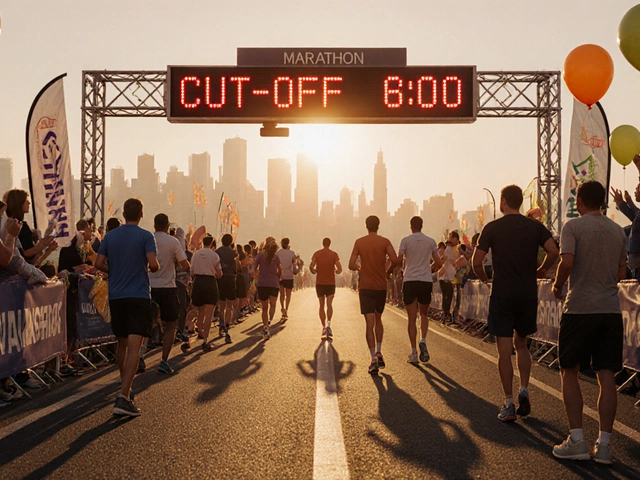How to Run a 10K When You Can Already Run a 5K

10K Training Plan Calculator
Your Recommended 10K Training Plan
You've managed the 5K distance, but the 10K still feels like a mountain. The good news? You can climb it with the right mindset, a sensible plan, and a few tweaks to your routine. Below you’ll learn exactly what to check, how to build stamina, and which pitfalls to dodge so you can cross the 10K finish line confident and injury‑free.
Key Takeaways
- Boost weekly mileage by 10‑15% each week and include one long run that reaches 8-10km before race day.
- Mix easy runs, tempo work, and interval sessions to improve both endurance and speed.
- Pay attention to pacing; start slower than your 5K pace and aim for a negative split.
- Strengthen core and leg muscles and schedule regular rest days to keep injuries at bay.
- Choose shoes with enough cushioning and support for the extra distance.
Ready to turn that curiosity into a finish line? Let’s break it down step by step.
1. Assess Your Current Fitness Level
Before you add another 5km, you need a realistic snapshot of where you stand. Ask yourself:
- Can you comfortably finish a 5K in under 30minutes?
- Do you recover within a day after a hard effort?
- Is your resting heart rate consistently between 50‑70bpm?
If the answers are mostly yes, you have a solid base. If not, spend a few weeks polishing those basics-easy runs, consistent weekly mileage, and proper hydration-before tackling a 10K specific schedule.
2. Understanding the 10K Difference
10K run is a distance of 10 kilometres (6.2miles) that challenges aerobic endurance more than speed alone. Compared with a 5K, the 10K requires:
- Higher weekly mileage (usually 30‑45km vs 15‑20km).
- Longer sustained effort at a steady, comfortable pace.
- More emphasis on fueling and hydration for runs over 45minutes.
Because of these factors, a 10K plan adds a weekly long run, slightly longer tempo pieces, and a bit of strength work.
3. Building a 10K‑Ready Training Plan
The simplest way to progress is to follow a 8‑week program that gradually ramps up volume. Here’s a template you can adapt:
| Week | Key Sessions | Total km | Long Run |
|---|---|---|---|
| 1 | 3 easy runs, 1 tempo (3km @ 10K pace) | 20‑22 | 6km |
| 2 | 4 runs (incl. 1 interval: 5×400m), 1 tempo (4km) | 22‑24 | 7km |
| 3 | 3 easy, 1 hill repeat, 1 tempo (5km) | 24‑26 | 8km |
| 4 | Recovery week - cut volume 20% | 19‑20 | 6km |
| 5 | 4 runs (incl. 6×400m), tempo 6km | 26‑28 | 9km |
| 6 | 3 easy, hill repeat, tempo 7km | 28‑30 | 10km |
| 7 | Reduced volume, short intervals, race‑pace strides | 22‑24 | 8km |
| 8 | Taper - light jogs, 2km at race pace | 15‑18 | 5km |
Key points:
- Long run builds endurance; keep it 60‑90 seconds slower than your target 10K pace.
- Tempo runs improve lactate threshold, allowing you to hold a faster pace for longer.
- Intervals sharpen speed without adding too much fatigue.
Remember the 10% rule: don’t increase weekly mileage by more than 10‑15% to stay injury‑free.
4. Pacing Strategies for Race Day
Many runners make the mistake of starting too fast, fueled by their 5K speed. The smartest approach is a **negative split**-run the second half slightly faster than the first.
Use this simple formula: take your recent 5K pace, add 15‑20 seconds per kilometre, and that's your target 10K pace. For example, if you’ve been hitting 5:30min/km for 5K, aim for about 5:45-5:50min/km for the 10K.
Practice this in a tempo run: start at 6:00min/km for the first 3km, then drop to 5:45min/km for the remaining 2km. The feeling of finishing slightly quicker will become second nature on race day.
5. Nutrition and Hydration Basics
A 10K usually lasts between 45‑70minutes, so you don’t need elaborate fueling, but you shouldn’t ignore it either.
- Eat a balanced meal with carbs, protein, and a little fat 2‑3hours before the run.
- Stay hydrated; sip about 150‑250ml of water 15minutes before you start.
- If you tend to sweat heavily, consider a sports drink with electrolytes for runs over 60minutes.

6. Gear Check: Shoes, Apparel, and Tech
Running shoes should provide enough cushioning for the added distance while maintaining a responsive feel. Look for:
- Mid‑sole stack height of 20‑30mm for comfort.
- Support that matches your foot type (neutral, stability, or motion control).
- Less than 300‑350km of mileage left before you need a replacement.
Technical extras like a GPS watch help you monitor pace and distance. Set alerts for “split time” so you can stay on target without constantly checking the screen.
7. Injury Prevention and Recovery
Jumping from 5K to 10K adds stress to the hamstrings, calves, and knees. Incorporate these habits:
- Dynamic warm‑ups (leg swings, high‑knees) before every run.
- Post‑run static stretches, focusing on the hip flexors and calves.
- Strength sessions twice a week: squats, lunges, planks, and single‑leg bridges.
- One full rest day plus an active recovery day (easy bike or swim) each week.
Watch for warning signs: persistent soreness, swelling, or a sharp “pop” during a run. If anything feels off, scale back mileage and consider consulting a physiotherapist.
8. Mental Tricks to Keep You Going
Even a well‑trained body can quit if the mind says “stop.” Try these simple tricks:
- Chunk the race into three parts; celebrate each kilometre you finish.
- Use a mantra (“strong, steady, steady”) to drown out negative thoughts.
- Visualize crossing the finish line during your long runs-mental rehearsal builds confidence.
By combining steady mileage, smart pacing, and a little mental game‑play, you’ll discover that a 10K is just a longer version of the 5K you already know.
Frequently Asked Questions
How long should I take to transition from a 5K to a 10K?
Most runners need 6‑8weeks of consistent training, adding roughly 10‑15% mileage each week, before they feel comfortable tackling the 10K distance.
Can I keep my current 5K pace for the entire 10K?
It’s usually too fast. A sustainable 10K pace is about 15‑20seconds per kilometre slower than your best 5K pace. Aim for a negative split to finish strong.
Do I need to change my shoes for 10K training?
If your current shoes have less than 300km left, replace them. Look for a model that offers a bit more cushioning and support for longer runs.
What should I eat the night before a 10K race?
A carbohydrate‑rich dinner-think pasta, rice, or sweet potatoes-paired with lean protein and some veggies. Keep it familiar; avoid anything that could upset your stomach.
How can I avoid hitting the ‘wall’ halfway through the race?
Start slower than you feel you can, stay hydrated, and maintain a steady breathing rhythm. A well‑planned long run in training will also condition your body to handle the distance.




